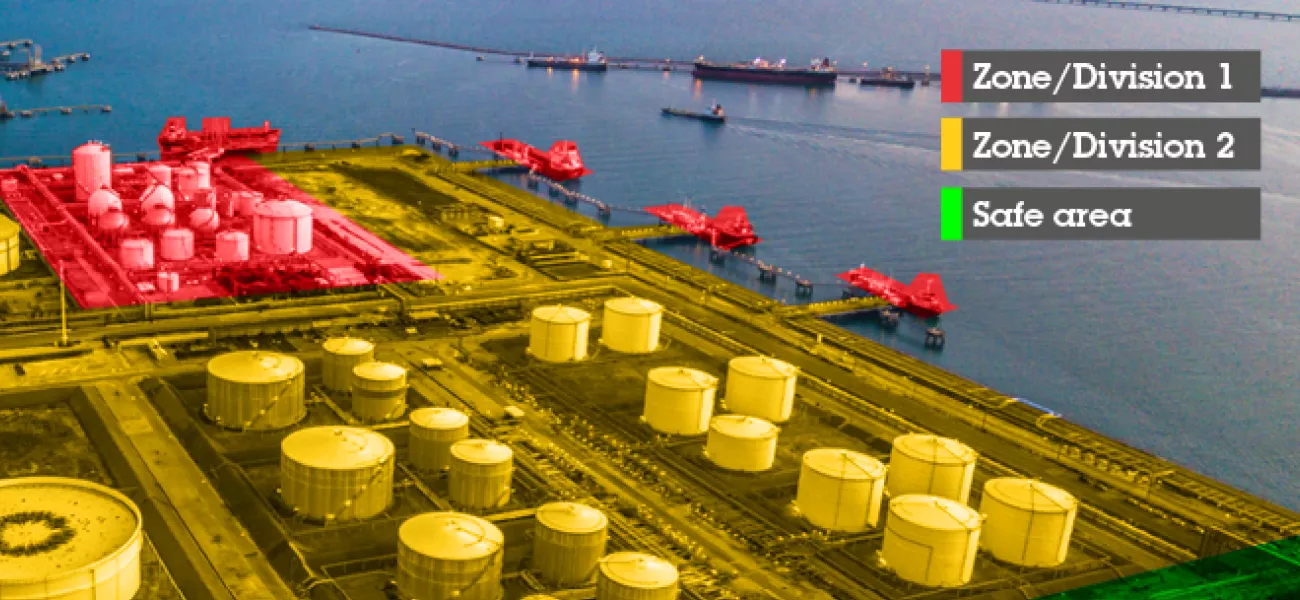
Hazardous areas where flammable material such as gas or dust are liable to an increased risk of explosion are common in settings ranging from petrochemical plants through to food processing factories.
Often, it’s essential or beneficial to use electrical equipment in these environments. This includes network cameras to ensure health and safety, security, and operational efficiency. However, any electrical equipment has to be certified for use in these areas as otherwise they may be liable to emit sparks, arcs, or cause hot surfaces sufficient to ignite a flammable gas or dust, potentially resulting in a catastrophic explosion.
Defining hazardous areas
A hazardous area is one in which a potentially combustible atmosphere due to gas or dust is present continuously or for shorter periods of time. These locations are divided into Divisions (in North America) or Zones (rest of the world).
Zone/Division 1 is a location where a combustible atmosphere is present for longer periods of time, typically in the production area. Areas further away from the source of the flammable material, where concentrations drop and the risk of an explosion is far lower, but still possible, are defined as Zone/Division 2.
The challenge for Zone/Division 2
For surveillance cameras used in Zone/Division 1, the only practical explosion protection method is a robust external enclosure around the entire camera, typically constructed from stainless steel or aluminum. The enclosure is not designed to keep the explosive gas from entering the enclosure, but rather to contain any arcs and sparks created by the camera to spread to the exterior, potentially igniting flammable material in the atmosphere.
Zone/Division 2 areas do not necessarily require the use of an external enclosure - known as an ‘Ex d’ enclosure - as long as the design does not permit any arcs or sparks to occur from the electronics, and that the temperature cannot exceed certain levels.
However, given the lack of alternatives, the only option for many organizations for surveillance in Zone/Division 2 areas has been to either use more expensive explosion-protected cameras certified for Zone/Division 1 or, potentially, forgo surveillance cameras in these areas altogether. The former often means fewer cameras are used than would be ideal, resulting in less extensive coverage. The latter, of course, means no surveillance in Zone/Division 2 areas at all, creating significant risk to health and safety, security, and a reduction in operational efficiency.
A new generation of explosion-protected cameras
Today, explosion-protected cameras designed and certified specifically for the requirements of Zone/Division 2 hazardous locations are available. By design, the camera is prevented from providing sufficient energy to ignite gas or dust in the atmosphere and cause an explosion. This design includes internal protection as well as the means to mechanically secure cable connectors that prevent accidental disconnection, removing the potential of energy transition and preventing the risk of sparks, arcs, or overheating.
Being smaller, lighter, and easier to install, this significantly reduces the total cost of ownership. And, for organizations where using explosion-protected cameras in Zone/Division 2 was previously cost prohibitive, the development of cameras specifically for these areas is extending health and safety measures, security, and opportunities to improve operational efficiency.
The new cameras also include analytics and features including smoke and fire alert for early prevention, PPE detection, and restricted area monitoring, further enhancing safety and security.
Regulations for Zone/Division 2 cameras are no less stringent than those for Zone/Division 1. Certified cameras need to have been tested and approved for IEC60079 Zone 2, 22 hazardous areas, as well as Class I/II/III Division 2, recognized in North America.
Common for the development of any explosion-protected camera, the manufacturer also needs an independently audited quality management system to ensure compliance between tested and manufactured product.
Advantages across multiple environments
The development of Zone/Division 2 explosion-protected cameras has advantages for both large- and small-scale facilities.
For example, operators of oil & gas plants that currently use Zone/Division 1-compliant cameras in Zone/Division 2 areas – which are typically much larger areas - the new cameras present both a significant cost saving opportunity and the chance to extend detailed surveillance coverage across the entire Zone/Division 2 area.
Many smaller organizations and sites with Zone/Division 2 hazardous areas choose not to use explosion-protected surveillance cameras at all, due to the prohibitive cost of having to use Zone/Division 1-certified cameras in these areas. Thanks to the introduction of Zone/Division 2 cameras, they can now benefit from improved health and safety, security, and operational efficiency across their entire facility. This can include sectors such as pharmaceutical production, agricultural silos for grain storage, mills and food production, wood mills, and more.
Zone/Division classification brings improved camera choice
Organizations operating facilities where hazardous areas exist will be well-aware of the different classifications, and regulatory requirements for any electrical equipment used in each. Failure to comply will have serious consequences: at minimum potential fines, but far more seriously posing a risk to employee safety.
For video surveillance in Zone/Division 2 hazardous areas, the choice has been difficult. Either use more costly Zone/Division 1 cameras, or forgo video surveillance entirely. Neither has been ideal.
Today, the need to compromise has been removed. Surveillance cameras certified for use in Zone/Division 2 areas are available, bringing high-quality video surveillance and advanced analytics to these areas. With them comes improved health and safety, security, and the opportunity to optimize operational efficiency.
